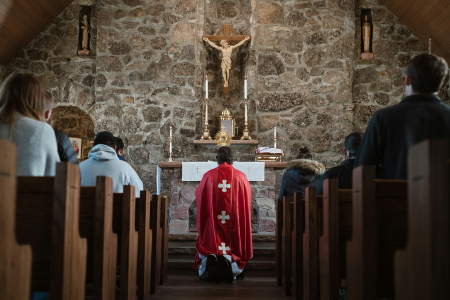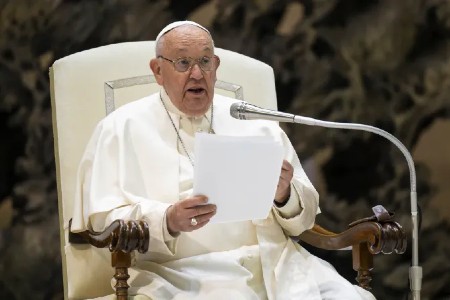Bartholomeu Lourenço de Gusmão
FREE Catholic Classes
Naturalist, and the first aeronaut; b. in 1685 at Santos in the province of São Paulo , Brazil ; d. 18 November, 1724, in Toledo, Spain. He began his novitiate in the Society of Jesus at Bahia when he was about fifteen years old, but left the same in 1701. He went to Portugal and found a patron at Lisbon in the person of the Marquess d'Abrantes. He completed his course of study at Coimbra, devoting his attention principally to philology and mathematics, but received the title of Doctor of Canon Law. He is said to have had a remarkable memory and a great command of languages. In 1709 he presented a petition to King John V of Portugal, begging a privilege for his invention of an airship, in which he expressed the greatest confidence. The contents of this petition have been preserved, as well as a picture and description of his airship. Following after Francesco Lana, S.J., Gusmão wanted to spread a huge sail over a bark like the cover of a transport wagon; the bark itself was to contain tubes through which, when there was no wind, air would be blown into the sail by means of bellows. The vessel was to be propelled by the agency of magnets which, apparently, were to be encased in two hollow metal balls. The public test of the machine, which was set for 24 June, 1709, did not take place. According to contemporary reports, however, Gusmão appears to have made several less ambitious experiments with this machine, descending from eminences. His contrivance in the main represented the principle of the kite (aeroplane). In all probability he did not have magnets in the aforementioned metal shells, but gases and hot air generated by the combustion of various materials. It is certain that Gusmão was working on this principle at the public exhibition he gave before the Court on 8 August, 1709, in the hall of the Casa da India in Lisbon, when he propelled a ball to the roof by combustion. The king rewarded the inventor by appointing him to a professorship at Coimbra and made him a canon. He was also one of the fifty chosen members of the Academia Real da Historia, founded in 1720; and in 1722 he was made chaplain to the Court. He busied himself with other inventions also, but in the meantime continued his work on his airship schemes, the first idea for which he is said to have conceived while a novice at Bahia. His experiments with the aeroplane and the hot-air balloon led him to conceive a project for an actual airship, or rather a ship to sail in the air, consisting of a cleverly designed triangular pyramid filled with gas, but he died before he was able to carry out this idea. The fable about the Inquisition having forbidden him to continue his aeronautic investigations and having persecuted him because of them, is probably a later invention. The only fact really established by contemporary documents is that information was laid against him before the Inquisition, but on quite another charge. He fled to Spain and fell ill of a fever, of which he died in Toledo. He wrote: "Manifesto summario para os que ignoram poderse navegar pelo elemento do ar" (1709): "Varios modos de esgotar sem gente as naus que fazem agua" (1710); some of his sermons also have been printed.
Join the Movement
When you sign up below, you don't just join an email list - you're joining an entire movement for Free world class Catholic education.
-

-
Mysteries of the Rosary
-
St. Faustina Kowalska
-
Litany of the Blessed Virgin Mary
-
Saint of the Day for Wednesday, Oct 4th, 2023
-
Popular Saints
-
St. Francis of Assisi
-
Bible
-
Female / Women Saints
-
7 Morning Prayers you need to get your day started with God
-
Litany of the Blessed Virgin Mary
U.S. Catholic Parishes Experience Resurgence of Traditional Practices
-

Pope Francis Urges Faith and Prayers for Peace
-

Florida Welcomes Volunteer Chaplains to Public Schools
-
10 Fascinating Details About St. Joseph the Worker: Celebrating His Feast Day - May 1
-
St. Joseph the Worker: Model for Men, Young and Old
Daily Catholic
 Daily Readings for Thursday, May 02, 2024
Daily Readings for Thursday, May 02, 2024 St. Athanasius: Saint of the Day for Thursday, May 02, 2024
St. Athanasius: Saint of the Day for Thursday, May 02, 2024 The Our Father: Prayer of the Day for Thursday, May 02, 2024
The Our Father: Prayer of the Day for Thursday, May 02, 2024- Daily Readings for Wednesday, May 01, 2024
- St. Marculf: Saint of the Day for Wednesday, May 01, 2024
- To Saint Peregrine: Prayer of the Day for Wednesday, May 01, 2024
 Hi readers, it seems you use Catholic Online a lot; that's great! It's a little awkward to ask, but we need your help. If you have already donated, we sincerely thank you. We're not salespeople, but we depend on donations averaging $14.76 and fewer than 1% of readers give. If you donate just $5.00, the price of your coffee, Catholic Online School could keep thriving. Thank you. Help Now >
Hi readers, it seems you use Catholic Online a lot; that's great! It's a little awkward to ask, but we need your help. If you have already donated, we sincerely thank you. We're not salespeople, but we depend on donations averaging $14.76 and fewer than 1% of readers give. If you donate just $5.00, the price of your coffee, Catholic Online School could keep thriving. Thank you. Help Now >
![]()
Copyright 2024 Catholic Online. All materials contained on this site, whether written, audible or visual are the exclusive property of Catholic Online and are protected under U.S. and International copyright laws, © Copyright 2024 Catholic Online. Any unauthorized use, without prior written consent of Catholic Online is strictly forbidden and prohibited.
Catholic Online is a Project of Your Catholic Voice Foundation, a Not-for-Profit Corporation. Your Catholic Voice Foundation has been granted a recognition of tax exemption under Section 501(c)(3) of the Internal Revenue Code. Federal Tax Identification Number: 81-0596847. Your gift is tax-deductible as allowed by law.









 Daily Readings for Thursday, May 02, 2024
Daily Readings for Thursday, May 02, 2024 St. Athanasius: Saint of the Day for Thursday, May 02, 2024
St. Athanasius: Saint of the Day for Thursday, May 02, 2024 The Our Father: Prayer of the Day for Thursday, May 02, 2024
The Our Father: Prayer of the Day for Thursday, May 02, 2024
